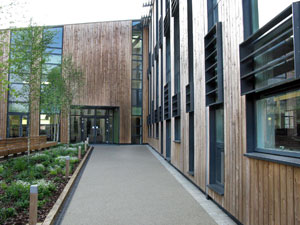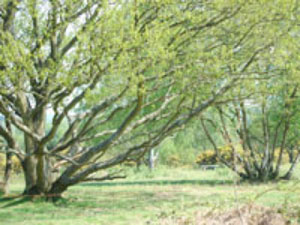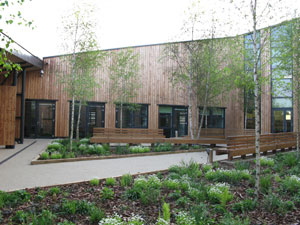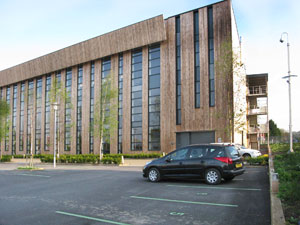WOODLAND TRUST : a leopard changing its spots?

The Woodland Trust has been going since 1972 and has grown into quite a big organisation with a turnover of over £25 million per year and it owns over 1,000 woodlands covering about 50,000 acres. It's big in other ways too with about 270 staff and a spanking new headquarters at Grantham which they moved into in mid-November 2010 and large collection of supporters and volunteers. Last year, the membership topped 200,000 and this had doubled over the previous 9 years.
Woodland Trust's new big objective - more trees!
So, in the woodland world it's a big beast but what does it do? Like a sea-going tanker changing direction the Woodland Trust has changed its objectives very significantly in the last year or two, under its CEO Sue Holden. From being a land-hungry charity which at one time bought or was given a new woodland every week, it has moved much more towards being a lobbying organisation with a passion for the creation of new woodlands. Referring to its objectives, Sue Holden says in the annual report that she wants "to persuade everyone to plant trees ...to create woodland", that she also wants to persuade "local authorities and community groups to create more woodland". She asks for their funding partners to support further tree planting and members to ask themselves what they can "do to ensure more trees are planted". So their new objective is clear and is very central to their lobbying: they now describe themselves in part as an advocacy organisation. They have set an example in doing large scale tree planting with a big project of 1,300 acres called "Heartwood" where over £9 million has been invested and well over 35,000 trees have already been planted and the Woodland Trust says it is creating "England's largest continuous new native forest".
 But how is the Woodland Trust funded?
But how is the Woodland Trust funded?
In a sense the answer is that it is very well-funded because it has successfully positioned itself as the leading woodlands charity in the UK and it own woodlands that it values (conservatively) at £63 million in addition to about £25 million of more liquid investments. It has a team of over 50 people doing fundraising and through them it is able to raise about £13 million each year of which one of the most significant sources is legacies, which result from the Woodland Trust being named in people's wills. Last year this amounted to about £7 million and the previous year to £8 million. But it has many other useful sources of funding such as the Landfill tax, Forestry Commission grants (over £1.2 million per year) and Lottery funding. It spends over £8 million of this income on the costs of employing its staff.
 Specifically what new planting does the Woodland Trust want?
Specifically what new planting does the Woodland Trust want?
Woodland Trust's objective is to lobby everyone they can think of to increase the annual rate of tree planting with a specific objective: they want to double the UK's native woodland tree cover over the next 50 years. Currently average UK tree cover (including coniferous woodlands) is just under 12% (but more in Scotland and Wales). They calculate this objective of doubling native tree cover will require 15,000 hectares of new broadleaved planting each year. That's a tough challenge as levels of new broadleaved planting have been reducing in recent years. Success will depend on government policy so the Woodland Trust realise that they need to lobby government actively and are making a concerted effort to do just that - they managed to get all the three main political parties to support new woodland creation as a manifesto commitment (and 800 parliamentary candidates signed up to the Woodland Trust's woodland creation objectives). The Trust has also recently organised an event at the House of Commons called "Growing the Future" hosted by Nicholas Boles where they launched their tree-planing agenda. Some people at the event were heard to express reservations wondering if agriculture can afford to lose so much land to new woodlands but most were very supportive and a gaggle of MPs and a couple of Lords turned up to talk woodlands with many representatives of the forestry industry. Caroline Spellman, of DEFRA, endorsed these aims and mentioned some of the projects that will help in promoting the Woodland Trust's woodland creation agenda - including the NHS forest, work on the Defence Estate, the Waste Management Sector projects and the More Woods project. There will also be some tree-related aspects to the Queen's 2012 event to celebrate Elizabeth II's 60 years' reign.
 Where does this leave the Woodland Trust?
Where does this leave the Woodland Trust?
Some people express annoyance at the extent to which the Woodland Trust set the national woodlands agenda (including that of the Forestry Commission) and it is true that they have galvanised DEFRA and others into working towards more tree planting. Thousands of people donate money to the Woodland Trust if these donors think general donations will be going towards buying and managing new woodlands they are probably mistaken - much of it will be going towards advocacy and campaigning. The Woodland Trust have indeed been buying some more land but not very much of it: last year they spent about £500,000 on woodland acquisitions and bought about six new woodlands totalling only 150 acres around the country, almost all of it to extend existing woodlands in their ownership. Where they have been buying larger woods such as the 240 hectares at Lang Craigs near Dumbarton, Scotland, they have been doing it with dedicated partners such as the Esmee Fairbairn Foundation.  But they have also been selling woods, which they describe as "transfers" - this must make business sense to rationalise their woodland portfolio which grew in a somewhat topsy-turvy manner but it can be slightly controversial where they dispose of woodlands that have been donated to them. For this reason, at least, their disposals have been low key and they tend to use local estate agents or contacts with neighbouring owners.
But they have also been selling woods, which they describe as "transfers" - this must make business sense to rationalise their woodland portfolio which grew in a somewhat topsy-turvy manner but it can be slightly controversial where they dispose of woodlands that have been donated to them. For this reason, at least, their disposals have been low key and they tend to use local estate agents or contacts with neighbouring owners.
We strongly support the Woodland Trust which is still growing but we observe that it has changed direction and is very much increasing its lobbying role from its newly built Grantham headquarters. What do you think?
Comments are closed for this post.
Discussion
Woodland Trust should concentrate on acquiring and maintaining MORE woodland. The more forest that is controlled, the louder the voice it has.
Selling land gifted to a trust is reprehensible, unless this was the givers intention.
I became a life-member of the Woodland Trust over twenty years ago because of its purpose to buy, collect, plant and protect woodland, not least against developers. I gave quite large donations each year to support that. Now, when even green belts are threatened and the Woodland Trust is richer than ever before, there is only silence it seems.
-
Where is this lobbying they claim to carry out?
Why are they not vocal in their protests against corrupt, counter-productive “green” schemes? Is it because they are now part of them?
Why are they claiming that “climate change” is the greatest threat to woodland, when the problem is clearly out-of-control population growth?
I don’t seem to receive either post or e-mails informing me of any campaigns. So now I don’t donate.
I have no faith in the board, over which I have no influence, or its metropolitan president-for-life.
I suspect the Woodland Trust has, like every other major charity, been absorbed into a form of government, in order to subvert the objectives of its founders and enable another agenda.
I have been invited over to the Woodland Trust for a job interview. I guess they are seriously considering my candidacy. Having previously worked in the software industry for years, my ex company was indeed all about the money. For me as a recent masters graduate in Sustainability Science and Policy, the notion of working for a charity, as corporate like as it may be, that has the objective of planting more trees, seems like a much much better option than most. I appreciate what Karl said. Indeed growth often brings structural change and recruits into top management will bring with them their corporate culture.
I would be happy if anyone could comment some more on what it is like to work there in 2016/2017.
The article says that the charity raises £13 million each year, and pays £8 million to staff. That is 62%. That seems amazingly high. Can you defend that amount?
I have been a member of the Woodland Trust for donkey’s years, and I too have noticed this change of direction, discussed above. I am not a very happy bunny to be honest. It is obviously up to them, but personally I would prefer the old method. In the old days, every time I received a newsletter, it gave details of “new woods” – all the woods that they had purchased or been gifted to them.
It was like a real charity then, but today it is more like a corporation, even quite a ruthless one like British Airways. It’s a pity, but I still support it because I am desperate to see more trees planted. Britain remains one of the least-wooded countries in Europe, with only Ireland, Iceland and Malta having less (not counting micro-nations like Monaco). So I guess anyone with a bit of clout and tree-planting on its agenda has my support.
From where to they buy their sapplings? Huge numbers of saplings have been imported from central Europe in recent years – as have the pests they contain. I suspect the Woodland Trust’s activities will be significantly responsible for the destruction of our ash and oaks (die back and caterpillars…)
Curiously young people are convinced that we have far fewer trees now than our grandparents; whereas all the photographic record of the UK ‘then and now’ shows the exact reverse to be the case. Countless beautiful scenic views in the UK that I saw in the 1960s have now vanished behind a wall of trees.
A very mixed reaction. Thw Woodland Triust does not have a good record as a forest manager,and its lobying is not seen as helpful in the forestry industry. The curious outdated obsession with native species and its views on coniferous forestry are well enough known, indeed it recently unleashed a well publicised campaign to get private woodland owners to rid themselves of coniferous plantations, on which employment in forestry and harvesting and timber supplies depend. All a bit bonkers.
And new planting? We all want this, but will the Trust continue to plant trees where they are not needed, close to the M25 and in rural Leicestershire, and set about re-creating lost woods in our Pennine National Parks? No way. This would be controversial and might affect fund raising, and we can’t have that.
Glad to hear of new thinking, good luck Sue but get real Woodland Trust and as soon as possible.
I’ve just finished speaking to a guy who cold called us. He was wearing a Woodland Trust tabard and what he said was very misleading. I asked him was any money involved. He said he was raising awareness of the Woodland Trust and the work they do and his job was to pass on peoples names to the Woodland Trust if they were interested. Eventually I managed to weedle out of him that it would work out at 20p a day. Well according to my maths that is £73.00 per year!! I used to live near Grantham and am now living in Milton Keynes where I am a volunteer with The Parks Trust which does conservation/habitat work so I know a bit about woodlands. Having read the above article i am more alarmed than ever about the Woodland Trust and the direction in which it is going.
As an ex-Woodland Trust employee I’d like to make a few comments here if I may. The Woodland Trust has become a very Corporate animal who ruthlessly pursue members, money and corporate partners. Most of the top directors at the Woodland Trust have little if any conservation or woodland experience and it’s really starting to show in how the organisation is run and the direction in which it is heading, for example Sue Holden herself includes on her resume a spell working for an oil company I believe BP, you have a director whose previous role was working for Kit Kat and another the financial company Credit One.
The Woodland Trust has gone from being a decent, well respected, well meaning woodland conservation charity to a ruthless corporate business. The organisation itself is run in such a way so as not to be disimilar to a Stalanist style regime with regular restructuring and redundancies (purges)of staff in what has to be said somewhat dubious legal circumstances that has led to out of court settlements, a Personal Development Review system where staff are purposely marked down and achievement ignored or played down in a twisted attempt to motivate, new staff constantly being brought in from outside the organisation whilst staff with many years of experience are made redundant and a predeliction for encouraging teams internally to vie with each other for the attention of key managers so as to constantly justify the existence of their job roles. The whole organisation thrives on fear and propaganda which in turn results in staff being forced into a position where being completely target driven dubious achievements are promoted and claimed by teams. A good example would be Woodland Creation where I know for a fact that staff members have been put into a position where they will only have to literally speak to someone on the phone for 5 minutes about Woodland Creation and the number of trees and hectarage of land being planted and discussed is then added to the Woodland Trusts own Woodland Creation figures. Activity like this cultivated by fear is wide spread across the Woodland Trust.
Woodland Creation on others property to which members may not have access and to which there is no guarantee as to the longevity of the planting is pretty appalling when you think about it. I’d like to know how members would feel if they knew that they were essentially donating money to beautify the property of the wealthy in society. You’ve already mentioned the fact that the Woodland Trusts “disposals process” isn’t widely known about. The Woodland Trust even undertakes the very dubious action of door step selling putting it on a par with the likes of the power companies. Sue Holden had a poor reputation with staff at the National Trust previously where she played a key role in messing with the lives of the work force there through redundancy as a result of a major office move not at all dissimilar to that seen at the Woodland Trust. Not to mention that the Woodland Trust now carries out next to no management of its own woodlands, I really struggle with the claim “Leading woodland conservation chairty” as the Woodland Trust does very very little conservation work. The whole organisation is set up to serve big business through facilitating woodland creation and allowing said partners to claim green credentials whilst in the mean time hanckering to the egoic often ruthless ambitions of those corporate managers at the top of the organisation. My whole experience of working for the Woodland Trust has completely coloured my view of charities, what I’ve realsied is how easily people are susceptable to propaganda and be willing to follow a message and support an organisation that calls itself a charity without looking in any depth as to what it is exactly they are supporting. Sue Holden has and will do a lot more damage at the Woodland Trust reputationally, the sooner she moves on the better it will be for the organisation and those that work there.
sorry peter – there is another forest (the forest of dennis!) known as the heart of england forest
http://www.heartofenglandforest.com/maps.html
this is the one funded by Felix Dennis – actually he seems a very nice guy
My point is not about the eccentric guy in particular but more about the fact that despite the scale of the forest (it will be nearly 3 times as big as the Woodland trust estate) one doesn’t seem to hear about it –
The National Forest is a great project – They have increased woodland cover from c.6% to around 18%. Much of the funding is public funding with some private funding. I am not sure who you are talking about but if the new trees/woods are for public use/enjoyment does it matter ?
there is an enormous wood being planted now across
200 square miles of the Midlands, The National Forest is taking root in the heart of England across parts of Derbyshire, Leicestershire and Staffordshire
about 36 000 acres funded by some eccentric publisher.
don hear much about this? – any comments?
I very well written article – thanks
I think I read somewhere that grassland has a very positive effect on carbon dioxide levels, maybe not so good at maintaining the water table though which is good for stopping floods? Or, maybe grassland is better at this- discuss! Anyway the main point about nature is for humans to be as light of foot as possible, lobby groups/pressure is not ‘light’ in my opinion.
I think it will come home to bite eventually.
i work for a large charity that has done the same, withdrawing `front-line commitment` to a significant degree… and alienating our partners.
Setting yourself up more as a `lobbying` organisation is fine all the time the wind blows your way…………..

Was thinking of buying a memorial space for my family….will find an alternative…all the information very depressing.
niah richards
15 August, 2018